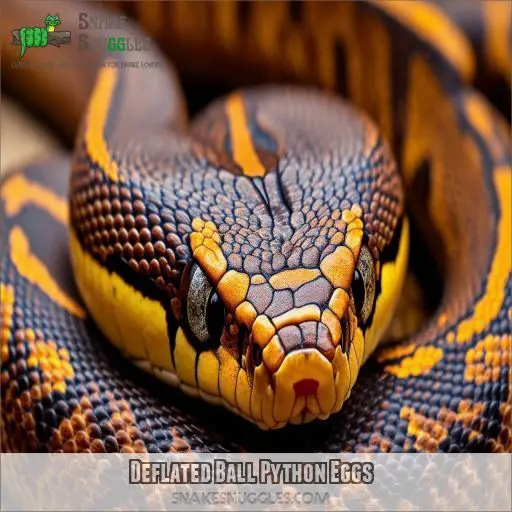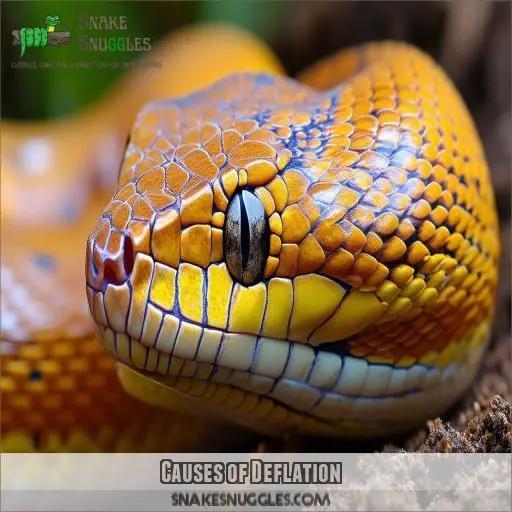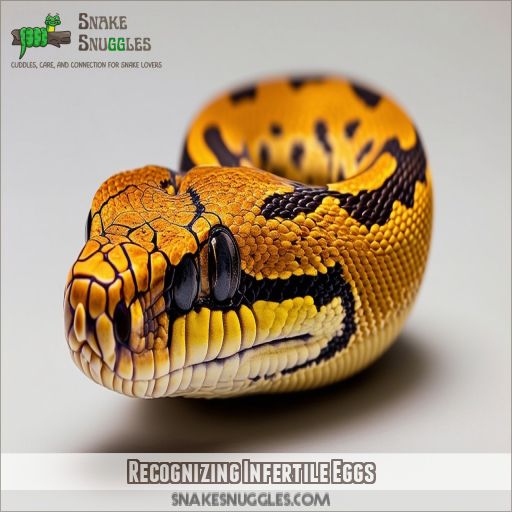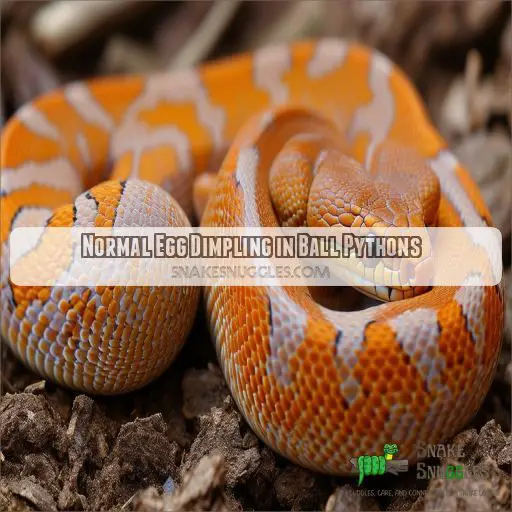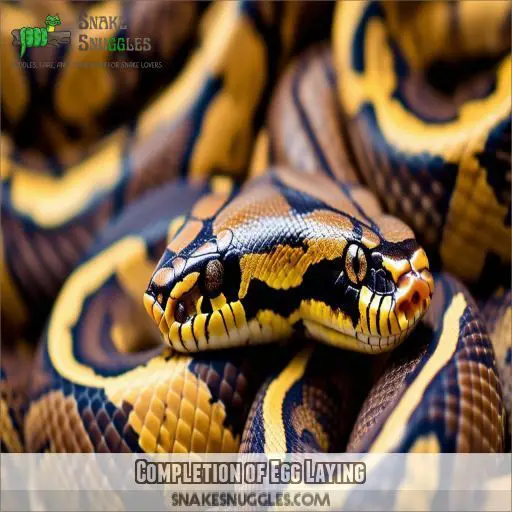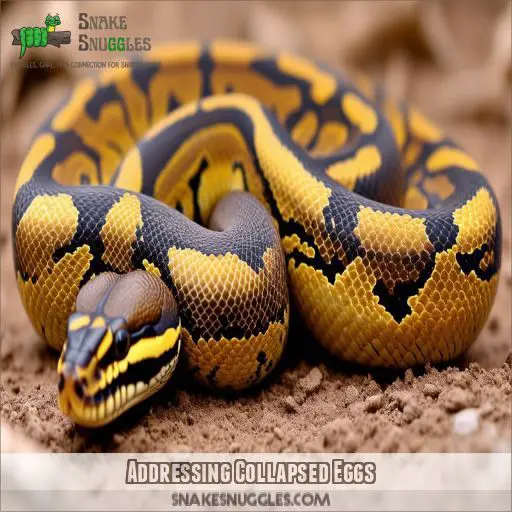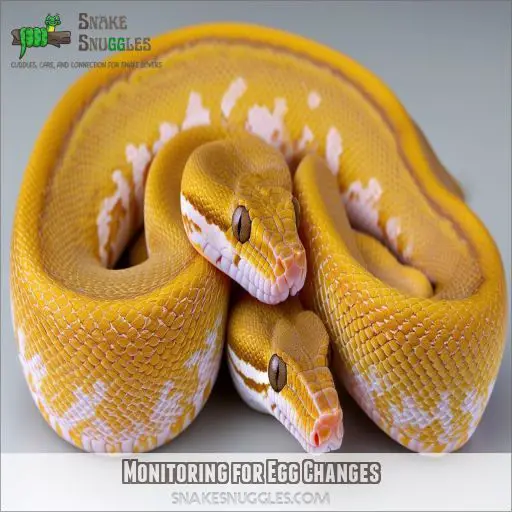This site is supported by our readers. We may earn a commission, at no cost to you, if you purchase through links.
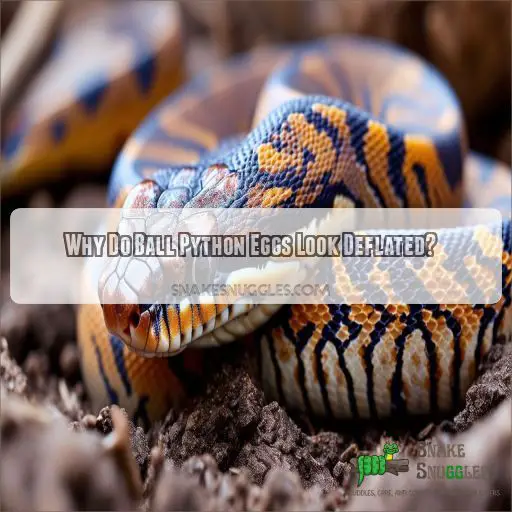 Ball python eggs represent new life, but occasionally, they can appear deflated or collapsed.
Ball python eggs represent new life, but occasionally, they can appear deflated or collapsed.
This phenomenon occurs when the environmental conditions, specifically humidity and temperature, deviate from the ideal range.
It is important to recognize that dimpling is a natural occurrence in ball python egg development and does not automatically indicate infertility or death.
In this article, we will delve into the reasons behind the deflated appearance of ball python eggs and offer guidance on addressing this concern.
Table Of Contents
- Key Takeaways
- Deflated Ball Python Eggs
- Causes of Deflation
- Recognizing Infertile Eggs
- Normal Egg Dimpling in Ball Pythons
- Completion of Egg Laying
- Addressing Collapsed Eggs
- Salvaging Collapsed Eggs
- Monitoring for Egg Changes
- Frequently Asked Questions (FAQs)
- What does a bad ball python egg look like?
- What do infertile ball python eggs look like?
- Is it normal for ball python eggs to dimple?
- How do you know when a ball python is done laying eggs?
- How long do ball python eggs usually take to hatch?
- What causes ball python eggs to collapse?
- What are the signs of a healthy ball python egg?
- How often should I candle ball python eggs?
- What should I do if my ball pythons eggs are not developing properly?
- Conclusion
Key Takeaways
- Don’t panic if your ball python eggs resemble deflated balloons. It might not indicate an issue.
- Maintain humidity. Ensure sufficient moisture for the eggs; otherwise, they tend to resemble raisins.
- Monitor the substrate carefully. If it’s too dry, it will draw moisture away from the eggs, causing them to shrivel.
- Resist the urge to constantly check on the eggs. Doing so can decrease humidity levels and impact the eggs’ well-being.
Deflated Ball Python Eggs
As a breeder, it is understandable to be concerned if your ball python eggs look deflated and wrinkled.
This appearance can result from a variety of factors, which we will explore in detail.
Environmental conditions and the natural process of eggs approaching hatching are potential causes.
Let’s delve further into this topic to address your concerns and provide guidance on ensuring the health and viability of your ball python eggs.
Causes of Deflation
Various factors can cause ball python eggs to look deflated, such as insufficient humidity, inadequate substrate moisture, and a malfunctioning hygrometer. Additionally, eggs nearing hatching or the impact of frequently removing the egg box lid can contribute to their deflated appearance.
Insufficient Humidity
Inadequate humidity is a critical factor in ball python egg deflation. Here are three key points to contemplate:
- Humidity Levels: Maintain suitable humidity levels within the ball python egg container. Insufficient humidity can lead to egg dehydration and deflation.
- Egg Dimpling: While some dimpling is normal, excessive dimpling can indicate inadequate humidity. This may cause the eggs to collapse, affecting the embryos’ development.
- Hygrometer Use: Utilize a hygrometer to accurately monitor humidity levels. This tool ensures you provide the correct environment for your ball python eggs, helping to prevent deflation due to dryness.
Inadequate Substrate Moisture
Another reason why ball python eggs may look deflated is due to inadequate substrate moisture. This occurs when the substrate, or bedding material, in the incubation container isn’t adequately moist, leading to a decrease in humidity levels. This can cause the eggs to lose moisture and appear deflated or wrinkled.
To prevent this, it’s important to maintain proper substrate moisture levels. The substrate should be slightly damp but not soaking wet. You can use a variety of materials as a substrate, such as vermiculite, perlite, or aspen shavings.
Here’s a quick overview of the different substrates and their benefits:
| Substrate | Advantages | Disadvantages |
|---|---|---|
| Vermiculite | Retains moisture well, easy to work with | Can be dusty, may need to be mixed with other materials |
| Perlite | Sterile, lightweight, doesn’t compact easily | Doesn’t retain moisture as well as vermiculite |
| Aspen Shavings | Natural, absorbent, provides insulation | May need to be changed more frequently |
Malfunctioning Hygrometer
Another potential cause of deflated ball python eggs is a malfunctioning hygrometer. This device measures humidity, a critical factor in the incubation process. If it’s inaccurate, you might inadvertently create an environment that’s too dry for the eggs, leading to their deflation. To prevent this, verify that your hygrometer is accurate and functioning properly.
Eggs Approaching Hatching
As the hatching period approaches, ball python eggs may naturally lose some of their firmness and appear slightly deflated. This is a normal part of the incubation process and doesn’t necessarily indicate a problem. Here are some key considerations regarding this stage:
- Hatching Procedure: It’s important to maintain favorable moisture levels during this period. Make sure the substrate is slightly damp, and consider using a humid hide to create a localized moisture source.
- Egg Viability: Regular candling can help assess egg viability. As the hatching date nears, you may notice increased dimpling and even the outline of the baby python inside.
- Incubation Period: The average incubation period for ball python eggs is around 55-60 days. Keep a close eye on the eggs during this time, as the hatching process may vary slightly between clutches.
Impact of Removing Egg Box Lid
Removing the lid from an egg box can cause a fluctuation in humidity, leading to deflation.
This is due to the sudden exposure to drier air, which draws moisture out of the eggs.
The movement of eggs during handling can also cause membrane damage, further contributing to moisture loss and deflation.
Additionally, clutch size can impact eggs’ vulnerability to deflation when the lid is removed, especially in larger clutches. Smaller clutches may be more susceptible as there are fewer eggs to maintain a stable humidity level within the box.
Recognizing Infertile Eggs
Recognizing infertile eggs is an indispensable aspect of ball python breeding. Here are three key points to examine:
- Egg Viability Assessment: It’s essential to evaluate the viability of eggs promptly. Candling is a common technique where a bright light is shone through the egg to scrutinize its contents. A viable egg will exhibit a discernible network of veins, while an infertile egg may appear opaque or lack distinct features.
- Clutch Size Optimization: While clutch size can vary, a markedly smaller number of eggs may indicate potential infertility issues. It’s important to contemplate the snake’s age, health, and breeding history when evaluating clutch size.
- Environmental Parameter Monitoring: Infertility can sometimes be traced to suboptimal environmental conditions. Monitoring factors such as temperature, humidity, and substrate moisture levels is critical for ensuring successful breeding. Deviations from the ideal parameters may impact egg fertility.
Normal Egg Dimpling in Ball Pythons
While it’s important to recognize infertile eggs, it’s also essential to understand that some dimpling in ball python eggs is normal and doesn’t necessarily indicate a problem. This dimpling can be influenced by various factors, such as egg viability, substrate choice, and handling techniques, all of which can impact the shape of the eggs and, ultimately, the health of the hatchlings.
Ball python eggs are soft and flexible, so it’s natural for them to change shape slightly as the embryo inside grows and develops. This can cause the eggs to dimple or appear slightly indented. However, significant or rapid dimpling can be a cause for concern, as it may indicate dehydration or other issues.
Completion of Egg Laying
Now that you’ve learned about the normal dimpling of ball python eggs, it’s important to understand the egg-laying process and potential issues that can cause deflation.
During incubation, these eggs require a carefully controlled humid environment to ensure their health and viability.
To complete the egg-laying process successfully, close monitoring of the eggs and maintenance of suitable environmental conditions are crucial. This includes paying close attention to humidity levels, which can be adjusted using damp substrates or humidity-retaining containers.
Addressing Collapsed Eggs
If your ball python eggs appear deflated, confirm you’re maintaining appropriate humidity and moisture levels in the incubation environment. If the deflation persists despite your efforts, it’s best to consult a veterinarian for further guidance on addressing the problem.
Ensuring Proper Humidity and Moisture
If your ball python eggs appear deflated, immediate action is necessary to establish suitable humidity and moisture levels. Here are three critical steps to resolve this situation:
- Maintain ideal humidity levels: Ball python eggs necessitate a humid environment for proper development. Utilize a hygrometer to monitor the humidity within your incubator or enclosure, aiming for a relative humidity of approximately 60-70%.
- Provide sufficient substrate moisture: The substrate, or bedding material, should be slightly moist to retain moisture. Avoid excessive dampness, as this may promote fungal growth and respiratory concerns in hatchlings.
- Minimize opening of the egg box lid: Excessive lid openings can induce rapid fluctuations in humidity and temperature, disrupting the eggs’ development. Limit disturbances and ensure the lid is secure when closed.
Seeking Veterinary Advice for Persisting Deflation
If the egg remains deflated despite your best efforts to maintain proper humidity, it’s time to seek veterinary advice. This is especially important if you suspect infertility or egg damage.
Veterinarians can assess the egg’s viability and provide guidance on environmental optimization, ensuring the proper humidity levels for ball python eggs. They may also offer insights into the potential causes of persistent deflation, addressing any concerns about egg damage or infertility.
Salvaging Collapsed Eggs
If your ball python eggs have collapsed, there are a few steps you can take to try and salvage them:
- Guarantee proper humidity levels: Check the humidity levels in your incubator and adjust them if necessary. Aim for a relative humidity of around 90-95%.
- Monitor egg condition: Keep a close eye on the eggs and look for any changes in their appearance. If the eggs continue to collapse or show other signs of distress, such as a strange odor or discoloration, seek veterinarian assistance.
- Maintain substrate moisture: Make sure the substrate is slightly moist to provide a humid environment for the eggs. However, be careful not to over-saturate it, as too much moisture can also be detrimental.
Monitoring for Egg Changes
Monitoring the development of ball python eggs is a critical aspect of ensuring their viability and healthy growth. Here are some key considerations for effective egg monitoring:
| Topic | Details |
|---|---|
| Egg Candling | This technique involves shining a bright light through the egg to assess its viability. It’s a non-invasive way to check for embryo development and detect any abnormalities. |
| Clutch Size | Monitoring the number of eggs laid can provide insights into the snake’s health and breeding success. A small clutch size might indicate a need for improved brumation and preparation. |
| Environmental Conditions | Guarantee optimal humidity and substrate moisture levels to support egg development. Regularly check and adjust these conditions as needed. |
| Egg Dimpling | Keep an eye out for normal dimpling, which is a natural occurrence as the eggs approach hatching. However, severe or premature dimpling might indicate an issue with humidity or substrate moisture. |
| Veterinary Advice | If you notice persistent or worsening deflation, consult a veterinarian. They can provide expert advice and interventions to improve egg viability. |
Frequently Asked Questions (FAQs)
What does a bad ball python egg look like?
A bad ball python egg may appear deflated or collapsed due to inadequate humidity levels. Infertile eggs may be externally shrivelled and discoloured, appearing yellow or greenish.
What do infertile ball python eggs look like?
Infertile ball python eggs are known as "slugs" and are smaller, discolored, and externally shrivelled. They may appear yellow or greenish under a flashlight.
Is it normal for ball python eggs to dimple?
Dimpling is a natural part of ball python egg development. It’s usually due to incorrect humidity levels, but it can also be a sign that the eggs are about to hatch.
How do you know when a ball python is done laying eggs?
You’ll know a ball python is done laying eggs when she’s coiled up as if she’s finished. You can also run your fingers down her belly to feel for any more eggs.
How long do ball python eggs usually take to hatch?
So, you’re curious about the gestation period of ball python eggs, huh? Well, buckle up because it’s a wild ride. These eggs typically take around 50 to 60 days to hatch, but it can vary. Sometimes, they emerge as early as 52 days or take their sweet time and hatch after 55 days.
What causes ball python eggs to collapse?
Ball python eggs may collapse due to inadequate humidity levels. This can be caused by a loose egg box lid, a fan drying the eggs out, incorrect substrate, or an inaccurate hygrometer reading.
What are the signs of a healthy ball python egg?
Healthy ball python eggs have a mild, earthy odour and a slightly yellow or off-white colour. The shell should be firm and intact, with a slight heft indicating proper moisture content. A well-developed embryo with visible veins is another good sign.
How often should I candle ball python eggs?
It’s not necessary to candle ball python eggs often. It’s a good tool to check the fertility of freshly laid eggs, but excessive handling can damage the developing embryo.
What should I do if my ball pythons eggs are not developing properly?
If your ball python eggs aren’t developing properly, first verify their fertility and check for any external damage. Guarantee suitable environmental conditions, including appropriate humidity levels. Consult a veterinarian if issues persist.
Conclusion
Don’t panic if your ball python eggs look deflated. This is not always a sign of infertility or death.
This article has shed light on the natural occurrence of egg dimpling and the environmental factors that can cause a deflated appearance.
You now understand the importance of maintaining the right humidity and substrate moisture levels. The egg-laying process can also impact the appearance of eggs.
With this knowledge, you can take the necessary steps to address any issues and ensure the best outcome for your ball python eggs. Remember, if you have any concerns, you can always seek veterinary advice.

